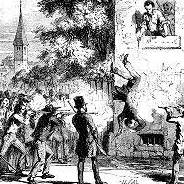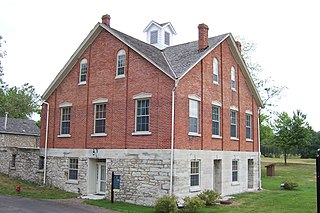
Hancock County is a county in the U.S. state of Illinois. According to the 2020 census, it has a population of 17,620. Its county seat is Carthage, and its largest city is Hamilton. The county is composed of rural towns with many farmers.

Nauvoo is a small city in Hancock County, Illinois, United States, on the Mississippi River near Fort Madison, Iowa. The population of Nauvoo was 950 at the 2020 census. Nauvoo attracts visitors for its historic importance and its religious significance to members of several groups: The Church of Jesus Christ of Latter-day Saints; the Community of Christ, formerly the Reorganized Church of Jesus Christ of Latter Day Saints (RLDS); other groups stemming from the Latter Day Saint movement; and the Icarians. The city and its immediate surrounding area are listed on the National Register of Historic Places as the Nauvoo Historic District.

Warsaw is a city in Hancock County, Illinois, United States. The population was 1,607 at the 2010 census, a decline from 1,793 in 2000. The city is notable for its historic downtown.

The Latter Day Saint movement is a religious movement within Christianity that arose during the Second Great Awakening in the early 19th century and that led to the set of doctrines, practices, and cultures called Mormonism, and to the existence of numerous Latter Day Saint churches. Its history is characterized by intense controversy and persecution in reaction to some of the movement's doctrines and practices and their relationship to mainstream Christianity. The purpose of this article is to give an overview of the different groups, beliefs, and denominations that began with the influence of Joseph Smith.

Maeser Elementary was an elementary school in Provo, Utah. It was named after Karl G. Maeser. Built in 1898, it is the oldest school building in Provo, Utah. The school was designed by architect Richard C. Watkins, who also designed the Provo Third Ward Chapel and Amusement Hall, The Knight Block Building, and the Thomas N. Taylor Mansion.
William Weeks, was the first church architect of the Church of Jesus Christ of Latter Day Saints, and is best known as the architect of the Nauvoo Temple.

Stone Hill Winery is a Missouri winery located in Hermann, Missouri, along the Missouri River, in what is called the Missouri Rhineland of the Hermann AVA. Established by German immigrants in 1847, it is the largest winery in the state.
Nauvoo State Park is an Illinois state park on 148 acres (60 ha) in Hancock County, Illinois, United States near the banks of the Mississippi River. It contains 13-acre manmade lake named Lake Horton, the Rheinberger House Museum, and Illinois’ oldest vineyard.

Joseph Smith, the founder and leader of the Latter Day Saint movement, and his brother, Hyrum Smith, were killed by a mob in Carthage, Illinois, United States, on June 27, 1844, while awaiting trial in the town jail.

Nauvoo Historic District is a National Historic Landmark District containing the city of Nauvoo, Illinois. The historic district is nearly coterminous with the City of Nauvoo as it was incorporated in 1840, but it also includes the Pioneer Saints Cemetery, the oldest Mormon cemetery in the area, which is outside the town boundary.
The Nauvoo Brass Band was an official musical organization of the Church of Jesus Christ of Latter Day Saints when the church's headquarters were located in Nauvoo, Illinois. It was later revived by the Church of Jesus Christ of Latter-day Saints in the Utah Territory.
The history of Nauvoo, Illinois, starts with the Sauk and Meskwaki tribes who frequented the area, on a bend of the Mississippi River in Hancock County, some 53 miles (85 km) north of today's Quincy. They called the area "Quashquema", in honor of the Native American chief who headed a Sauk and Fox settlement numbering nearly 500 lodges. Permanent settlement by non-natives was reportedly begun in 1824 by Captain James White. By 1830, the community was called "Venus", and it was the site of the first post office in the county. In 1834 the name Venus was changed to "Commerce" in anticipation that the town would prosper under the United States' westward expansion.

The Nauvoo House in Nauvoo, Illinois, is a boarding house that Joseph Smith, the founder of the Latter Day Saint movement, began constructing in the 1840s. The boarding house was never completed, but the structure was later converted into a residential home and renamed the Riverside Mansion. The Nauvoo House, as it is referred to today, is part of the Nauvoo Historic District, a National Historic Landmark.

Harvey H. Cluff (1836–1916) was a business, civic and educational leader in late-19th-century Provo, Utah.

The St. George Opera House, also known as the St. George Social Hall, is a historic building in St. George, Utah. It was originally built by the St. George Gardeners' Club as a wine cellar. As wine demand decreased, the building was expanded to host theatrical productions. It operated in this capacity until sold to the Utah-Idaho Sugar Company in 1936. It was restored to an opera house in 1988 and is again open to the public.

Cambre House and Farm is a historic farmstead located southwest of Niota, Hancock County, Illinois, United States. The farmhouse was built in 1867 by Adolphe Cambre, a French immigrant and member of Nauvoo's short-lived Icarian community. A carpenter by trade, Cambre designed several of the community's buildings while the Icarians occupied Nauvoo in the 1850s. While many of the Icarians resettled in Corning, Iowa after their Nauvoo colony failed, Cambre remained in Hancock County, eventually building the Creole-inspired house for his family. The house is similar in design to the Icarians' other buildings and is the only surviving Icarian-designed building in Hancock County.

The Thomas Forsyth House is the historic home of an early settler of Toquerville, Utah. One of the Mormon pioneers, Thomas Forsyth built the house circa 1868 and lived there until his death in 1898. He operated mills, dried fruit and stocked the cellar with wine he made himself, while his wife Mary Browett Holmes ran a glove shop. The simple 1½-story fieldstone construction, a hall-and-parlor house extended with a lean-to, is representative of the pioneer period.

The William Stuart Seeley House is a historic house in Mount Pleasant, Utah. It was built in 1861, probably by William Stuart Seeley, an immigrant from Canada who converted to the Church of Jesus Christ of Latter-day Saints with his wife before moving to Nauvoo, Illinois. They relocated to Utah in 1847, and he was among Mormon settlers to move to a fort in Mount Pleasant in 1849. Seeley served as the bishop of Mount Pleasant for 29 years, and he was the first mayor of Mount Pleasant. He had ten children with his first wife, née Elizabeth DeHart, who died in 1872. The peace treaty of the Black Hawk War was reported signed in this house in 1872. Seeley later married Ellen Carter, with whom he had two children, and Ann Watkins, with whom he had two more children. Seeley died in 1895. The house has been listed on the National Register of Historic Places since July 16, 1992.

The Hunziker Winery Site is the site of a former winery in Cedar Glen State Natural Area near Warsaw, Illinois. The winery was established in the 1860s by vintner and Swiss immigrant Gottlieb Hunziker and his business partner William Hoffman. At the time, Hancock County was becoming a major winemaking region, and the Warsaw area was second only to Nauvoo as a wine center within the county. Hunziker's wine was well-regarded among his contemporaries, as he won multiple awards at the 1870 Iowa State Fair, held across the Mississippi River in Keokuk. Hunziker continued to produce wine until his death in 1893. The remains of the winery include the walls of its wine house, in which grapes were processed and fermented, and an underground wine cellar.


















